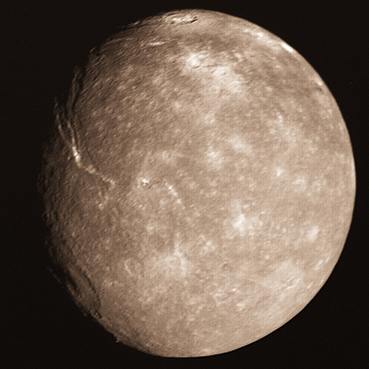 |
This is a file from the Wikimedia Commons. Information from its description page there is shown below.
Commons is a freely licensed media file repository. You can help.
|
Titania High-Resolution Colour Composite
This high-resolution color composite of Titania was made from Voyager 2 images taken Jan. 24, 1986, as the spacecraft neared its closest approach to Uranus. Voyager's narrow-angle camera acquired this image of Titania, one of the large moons of Uranus, through the violet and clear filters. The spacecraft was about 500,000 kilometers (300,000 miles) away; the picture shows details about 9 km (6 mi) in size. Titania has a diameter of about 1,600 km (1,000 mi). In addition to many scars due to impacts, Titania displays evidence of other geologic activity at some point in its history. The large, trenchlike feature near the terminator (day-night boundary) at middle right suggests at least one episode of tectonic activity. Another, basinlike structure near the upper right is evidence of an ancient period of heavy impact activity. The neutral gray colour of Titania is characteristic of the Uranian satellites as a whole. The Voyager project is managed for NASA by the Jet Propulsion Laboratory.
Source
| Public domainPublic domainfalsefalse |
 |
This file is in the public domain because it was solely created by NASA. NASA copyright policy states that "NASA material is not protected by copyright unless noted". (See Template:PD-USGov, NASA copyright policy page or JPL Image Use Policy.) |
|
|
|
Warnings:
- Use of NASA logos, insignia and emblems are restricted per US law 14 CFR 1221.
- The NASA website hosts a large number of images from the Soviet/ Russian space agency, and other non-American space agencies. These are not necessarily in the public domain.
- Materials based on Hubble Space Telescope data may be copyrighted if they are not explicitly produced by the STScI. See also {{ PD-Hubble}} and {{ Cc-Hubble}}.
- The SOHO (ESA & NASA) joint project implies that all materials created by its probe are copyrighted and require permission for commercial non-educational use.
- Images featured on the Astronomy Picture of the Day (APOD) web site may be copyrighted.
|
File usage
The following pages on Schools Wikipedia link to this image (list may be incomplete):
SOS Children has brought Wikipedia to the classroom. More than 2 million people benefit from the global charity work of SOS Children, and our work in 133 countries around the world is vital to ensuring a better future for vulnerable children. There are many ways to help with SOS Children's Villages.





